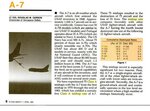I'm starting to build the beautiful 1:32 kit from Italeri of the F-104S and I reviewed a bit the story of the plane and its technical design.
One odd choice struck me. The F-104 was one of the first planes with blown flaps designed to reduce the landing speed. That would seem a most logical choice considering that when Johnson switched from the J65 engine to the more powerful J79, the plane grew in size and weight (over 1m longer and over one ton heavier) but the wing shape and area remained the same.
The thing is, blown flaps use air from the high pressure stage of the engine compressor. Said blown flaps don't work when the engine is idling; in order to be effective, the engine must be around 2/3 of thrust if I remember correctly from the flight manual.
So, in the end, you have blown flaps but that overgrown engine behind the pilot's ass is generating a lot of thrust because the compressor must be kept spinning at high revs to give enough air to the flaps. In addition to this, the pilot is also restricted in its angle of attack (both to increase the lift and use the induced drag to slow the airplane) because the T tail design must be kept clear of the wings wash, especially at low speeds, to avoid an hard tail stall.
So, in the end, was it a worthy addition? Why Johnson was so much worried about landing speed? At the time the USAF was using the F-84 which was notorious for its 'hairy' takeoff and landings at over 300 Km/h. Why not increasing the wing area a bit? The J79 powered F-104 was airspeed limited anyway, so it would have reached Mach 2+ even with slightly larger wings. Or maybe call it a day and accept a higher landing speed (The original XF-104 with its J65 had a landing speed of around 250 Km/h, so it was not that hot, even back in the day)?
One odd choice struck me. The F-104 was one of the first planes with blown flaps designed to reduce the landing speed. That would seem a most logical choice considering that when Johnson switched from the J65 engine to the more powerful J79, the plane grew in size and weight (over 1m longer and over one ton heavier) but the wing shape and area remained the same.
The thing is, blown flaps use air from the high pressure stage of the engine compressor. Said blown flaps don't work when the engine is idling; in order to be effective, the engine must be around 2/3 of thrust if I remember correctly from the flight manual.
So, in the end, you have blown flaps but that overgrown engine behind the pilot's ass is generating a lot of thrust because the compressor must be kept spinning at high revs to give enough air to the flaps. In addition to this, the pilot is also restricted in its angle of attack (both to increase the lift and use the induced drag to slow the airplane) because the T tail design must be kept clear of the wings wash, especially at low speeds, to avoid an hard tail stall.
So, in the end, was it a worthy addition? Why Johnson was so much worried about landing speed? At the time the USAF was using the F-84 which was notorious for its 'hairy' takeoff and landings at over 300 Km/h. Why not increasing the wing area a bit? The J79 powered F-104 was airspeed limited anyway, so it would have reached Mach 2+ even with slightly larger wings. Or maybe call it a day and accept a higher landing speed (The original XF-104 with its J65 had a landing speed of around 250 Km/h, so it was not that hot, even back in the day)?

